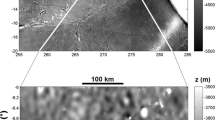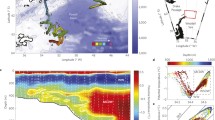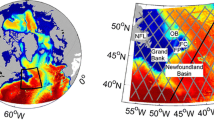Abstract
The importance of deep mixing in driving the deep part of the overturning circulation has been a long debated question at the global scale. Our observations provide an illustration of this process at the Timor Basin scale of ∼1000 km. Long-term averaged moored velocity data at the Timor western sill suggest that a deep circulation is present in the Timor Basin. An inflow transport of ∼0.15 Sv is observed between 1600 m and the bottom at 1890 m. Since the basin is closed on its eastern side below 1250 m depth, a return flow must be generated above 1600 m with a ∼0.15 Sv outflow. The vertical turbulent diffusivity is inferred from a heat and transport balance at the basin scale and from Thorpe scale analysis. Basin averaged vertical diffusivity is as large as 1 × 10−3 m2 s−1. Observations are compared with regional low-resolution numerical simulations, and the deep observed circulation is only recovered when a strong vertical diffusivity resulting from the parameterization of internal tidal mixing is considered. Furthermore, the deep vertical mixing appears to be strongly dependent on the choice of the internal tide mixing parameterization and also on the prescribed value of the mixing efficiency.








Similar content being viewed by others
References
Alford M, Gregg M, Ilyas M (1999) Diapycnal mixing in the Banda Sea: results of the first microstructure measurements in the Indonesian throughflow. Geophys Res Lett 26:2741–2744
Alford MH, Girton JB, Voet G, Carter GS, Mickett JB, Klymack J (2013) Turbulent mixing and hydraulic control of abyssal water in the Samoan Passage. Geophys Res Lett 40(17):4666–4674. doi:10.1002/grl.50684
Arneborg L (2002) Mixing efficiencies in patchy turbulence. J Phys Oceanogr 32(5):1496–1506
Barnier B, Madec G, Penduff T, Molines JM, Tréguier A-M, Le Sommer J, Beckmann A, Biastoch A, Boening C, Dengg J, Derval C, Durand E, Gulev S, Remy E, Talandier C, Theetten S, Maltrud M, McClean J, DeCuevas B (2006) Impact of partial steps and momentum advection schemes in a global ocean circulation model at eddy permitting resolution. Ocean Dyn 56(5-6):543–567
Barry ME, Ivey GN, Winters KB, Imberger J (2001) Measurements of diapycnal diffusivities in stratified fluids. J Fluid Mech 442(1):267–291
Blanke B, Delecluse P (1993) Variability of the tropical Atlantic ocean simulated by a general circulation model with two different mixed layer physics. J Phys Oceanogr 23:1363–1388
Bluteau CE, Jones NL, Ivey GN (2013) Turbulent mixing efficiency at an energetic ocean site. J Geophys Res: Oceans 118(9):4662–4672
Bouruet-Aubertot P, Cuypers Y, Ferron B, Dausse D, Menage O, Atmadipoera A, Jaya I (2012). Finescale parameterization of turbulent mixing and internal tides in the Indonesian Throughflow from INDOMIX experiment. In AGU Fall Meeting Abstracts (Vol. 1, p. 1872)
Boyer TP, JI Antonov, OK Baranova, C Coleman, HE Garcia, A Grodsky, DR Johnson, RA Locarnini, AV Mishonov, TD O'Brien, CR Paver, JR Reagan, D Seidov, IV Smolyar, MM Zweng (2013). World Ocean Database 2013, NOAA Atlas NESDIS 72, S. Levitus, Ed., A. Mishonov, Technical Ed.; Silver Spring, MD, 209 pp., 10.7289/V5NZ85MT
Brodeau L, Barnier B, Penduff T, Tréguier A-M, Gulev S (2010) An ERA40 based atmospheric forcing for global ocean circulation models. Ocean Model 31:88–104. doi:10.1016/j.ocemod.2009.10.005
Carrère L, Lyard F (2003) Modeling the barotropic response of the global ocean to atmospheric wind and pressure forcing: Comparisons with observations. Geophys Res Lett 30(6):1275. doi:10.1029/ 2002GL016473
Cowley R, B Heaney, S Wijffels, L Pender, J Sprintall, S Kawamoto, R Molcard (2008) INSTANT Sunda Data Report Description and Quality Control, available at http://www.marine.csiro.au/~cow074/INSTANTdataQC_v4.pdf
Davis KA, Monismith SG (2011) The modification of bottom boundary layer turbulence and mixing by internal waves shoaling on a barrier reef. J Phys Oceanogr 41(11):2223–2241
Decloedt T, Luther DS (2012) Spatially heterogeneous diapycnal mixing in the abyssal ocean: a comparison of two parameterizations to observations. J Geophys Res: Oceans 117(C11):1978–2012
de Lavergne C, Madec G, Le Sommer J, Nurser AG, Naveira Garabato AC (2015). The impact of a variable mixing efficiency on the abyssal overturning. Journal of Physical Oceanography
Dillon TM (1982) Vertical overturns: a comparison of Thorpe and Ozmidov length scales. J Geophys Res 87(C12):9601–9613. doi:10.1029/JC087iC12p09601
Ding Y, Bao X, Yu H, Kuang L (2012) A numerical study of the barotropic tides and tidal energy distribution in the Indonesian seas with the assimilated finite volume coastal ocean model. Ocean Dyn 62:515–532
Drushka K, Sprintall J, Gille ST, Brodjonegoro I (2010) Vertical structure of Kelvin waves in the Indonesian throughflow exit passages. J Phys Oceanogr 40:1965–1987
Dussin R, A-M Treguier, JM Molines, B Barnier, T Penduff, L Brodeau, G Madec (2009). Definition of the interannual experiment ORCA025-B83, 1958-2007. LPO Report 902
Egbert GD, Ray RD (2000) Significant dissipation of tidal energy in the deep ocean inferred from satellite altimeter data. Nature 405:775–778
Emile-Geay J, Madec G (2009) Geothermal heating, diapycnal mixing and the abyssal circulation. Ocean Sci 5:203–217
Fer I, Müller M, Peterson AK (2015) Tidal forcing, energetics, and mixing near the Yermak Plateau. Ocean Sci 11:287–304
Ferron B, Mercier H, Speer K, Gargett A, Polzin K (1998) Mixing in the Romanche fracture zone. J Phys Oceanogr 28(10):1929–1945
Ffield A, Robertson R (2008) Temperature finestructure in the Indonesian Seas. J Geophys Res Oceans, 113(C9)
Fieux M, Andrie´ C, Delecluse P, Ilahude AG, Kartavtseff A, Mantisi F, Molcard R, Swallow JC (1994) Measurements within the Pacific-Indian oceans throughflow region. Deep-Sea Res 41:1091–1130
Gargett AE (1988) The scaling of turbulence in the presence of stable stratification. J Geophys Res: Oceans (1978–2012) 93(C5):5021–5036
Gargett A, Garner T (2008) Determining Thorpe scales from ship-lowered CTD density profiles. J Atmos Ocean Technol 25(9):1657–1670
Gordon AL, Giulivi CF, Ilahude AG (2003) Deep topographic barriers within the Indonesian Seas. Deep Sea Res, Part II 50:2205–2228
Gregg MC, Alford MH, Kontoyiannis H, Zervakis V, Winkel D (2012) Mixing over the steep side of the Cycladic Plateau in the Aegean Sea. J Mar Syst 89(1):30–47
Haertel P, Fedorov A (2012) The ventilated ocean. J Phys Oceanogr 42:161–164
Heywood KJ, Naveira Garabato AC, Stevens DP (2002) High mixing rates in the abyssal Southern Ocean. Nature 415:1011–1014
Hogg N, Biscaye PE, Gardner W, Schmitz WJ Jr (1982) On the transport and modification of Antarctic bottom water in the Vema Channel. J Mar Res 40:231–283
Huang RX (1999) Mixing and energetics of the oceanic thermohaline circulation. J Phys Oceanogr 29:727–746
Hughes GO, Griffiths RW (2006) A simple convective model of the global overturning circulation, including effects of entrainment into sinking regions. Ocean Model 12:46–79
Jayne SR (2009) The impact of abyssal mixing parameterizations in an ocean general circulation model. J Phys Oceanogr 39:1756–1775
Kartadikaria AR, Miyazawa Y, Varlamov SM, Nadaoka K (2011) Ocean circulation for the Indonesian seas driven by tides and atmospheric forcings: comparison to observational data. J Geophys Res 116(C9):C09009
Katsumata K, Wijffels SE, Steinberg CR, Brinkman R (2010) Variability of the semidiurnal internal tides observed on the Timor Shelf. J Geophys Res 115(C10):C10008
Koch-Larrouy A, Madec G, Bouruet-Aubertot P, Gerkema T, Bessieres L, Molcard R (2007) On the transformation of Pacific Water into Indonesian Throughflow Water by internal tidal mixing. Geophys Res Lett 34:L04604. doi:10.1029/2006GL028405
Koch-Larrouy A, Madec G, Iudicone D, Atmadipoera A, Molcard R (2008a) Physical processes contributing to the water mass transformation of the Indonesian Throughflow. Ocean Dyn 58:275–288. doi:10.1007/s10236-008-0154-5
Koch-Larrouy A, Madec G, Blanke B, Molcard R (2008b) Water mass transformation along the Indonesian throughflow in an OGCM. Ocean Dyn 58:289–309. doi:10.1007/s10236-008-0155-4
Koch-Larrouy A, Atmadipoera A, van Beek P, Madec G, Aucan J, Lyard F, Souhaut M (2015) Estimates of tidal mixing in the Indonesian archipelago from multidisciplinary INDOMIX in-situ data. Deep Sea Research Part I: Oceanographic Research Papers
Koch-Larrouy A, Lengaigne M, Terray P, Madec G, Masson S (2010) Tidal mixing in the Indonesian Seas and its effect on the tropical climate system. Clim Dyn 34(6):891–904
Kunze E, Firing E, Hummon JM, Chereskin TK, Thurnherr AM (2006) Global abyssal mixin inferred from Lowered ADCP shear and CTD strain profiles. J Phys Oceanogr 36:1553–1576
Kunze E, MacKay C, McPhee-Shaw EE, Morrice K, Girton JB, Terker SR (2012) Turbulent mixing and exchange with interior waters on sloping boundaries. J Phys Oceanogr 42(6):910–927
Le Provost C, Genco ML, Lyard F, Vincent P, Canceil P (1994) Spectroscopy of the world ocean tides from a finite element hydrodynamic model. J Geophys Res 99:24,777–24,798
Le Sommer J, Penduff T, Theetten S, Madec G, Barnier B (2009) How momentum advection schemes influence current-topography interactions at eddy permitting resolution. Ocean Model 29:1–14. doi:10.1016/ j.ocemod.2008.11.007
Ledwell JR, Montgomery ET, Polzin KL, St. Laurent LC, Schmitt RW, Toole JM (2000) Evidence for enhanced mixing over rough topography in the abyssal ocean. Nature 403:79–182
Levitus S, T Boyer, M Conkright, T OBrian, J Antonov, C Stephens, L Stathopolos, D Johnson, R Gelfeld (1998). World Ocean database 1998, technical Report NESDID18, NOAA Atlas.
Locarnini RA, Mishonov AV, Antonov JI, Boyer TP, Garcia HE, Baranova OK, Zweng MM, Johnson DR (2010) World Ocean Atlas 2009, volume 1: temperature. In: Levitus S (ed) NOAA Atlas NESDIS 68, U.S. Government Printing Office, Washington, D.C., 184pp
Lozovatsky ID, HJS Fernando (2013). Mixing efficiency in natural flows. Philosophical Transactions of the Royal Society A: Mathematical, Physical and Engineering Sciences 371(1982)
MacKinnon J, Johnston TMS, Pinkel R (2008) Strong transport and mixing of deep water through the Southwest Indian Ridge. Nat Geosci 1:755–758
Madec G, Imbard M (1996) A global ocean mesh to overcome the north pole singularity. Clim Dyn 12:381–388
Madec G (2008) NEMO reference manual, ocean dynamic component: NEMO-OPA. Preliminary version, Tech. Rep. 27, Note du pôle de modélisation, Institut Pierre Simon Laplace (IPSL), France, ISSN No 1288-1619
Melet A, Verron J, Gourdeau L, Koch-Larrouy A (2011) Equatorward pathways of Solomon Sea water masses and their modifications. J Phys Oceanogr 41(4):810–826
Melet A, Hallberg R, Legg S, Polzin K (2013) Sensitivity of the ocean state to the vertical distribution of internal-tide-driven mixing. J Phys Oceanogr 43(3):602–615
Melet A, Hallberg R, Legg S, Nikurashin M (2014) Sensitivity of the ocean state to lee wave driven mixing. J Phys Oceanogr 44:900–921
Meyer A, Sloyan BM, Polzin KL, Phillips HE, Bindoff NL (2015) Mixing variability in the Southern Ocean. J Phys Oceanogr 45(4):966–987
Molcard R, Fieux M, Ilahude AG (1996) The Indo-Pacific throughflow in the Timor Passage. J Geophys Res 101(C5):12411–12420
Müller M, Cherniawsky JY, Foreman MGG, von Storch J-S (2012) Global M2 internal tide and its seasonal variability from high resolution ocean circulation and tide modeling. Geophys Res Lett 39:L19607. doi:10.1029/2012GL053320
Munk W (1966) Abyssal recipes. Deep-Sea Res 13:707–730
Munk W, Wunsch C (1998) Abyssal recipes II: energetics of tidal and wind mixing. Deep-Sea Res 45:1976–2009
Nagai T, Hibiya T (2015) Internal tides and associated vertical mixing in the Indonesian Archipelago. J Geophys Res: Oceans 120:3373–3390
Osborn TR (1980) Estimates of the local rate of vertical diffusion from dissipation measurements. J Phys Oceanogr 10(1):83–89
Penduff T, Le Sommer J, Barnier B, Treguier A-M, Molines JM, Madec G (2007) Influence of numerical schemes on current-topography interactions in ¼° global ocean simulations. Ocean Sci 3:509–524
Polzin KL, Toole JM, Schmitt RW (1995) Finescale parameterizations of turbulent dissipation. J Phys Oceanogr 25:306–328
Polzin KL, Toole JM, Ledwell JR, Schmitt RW (1997) Spatial variability of turbulent mixing in the abyssal ocean. Science 276(5309):93–96
Pratt LJ, JA Whitehead (2007). Rotating hydraulics—nonlinear topographic effects in the ocean and atmosphere, Springer, 608pp
Rudnick DL, Boyd TJ, Brinard RE, Carter GS, Egbert GD (2003) From tides to mixing along the Hawaiian Ridge. Science 301(5631):355–357
Saenko OA, Merryfield WJ (2011) On the effect of topographically enhanced mixing on the global ocean circulation. J Phys Oceanogr 35:826–834
St. Laurent L, Schmitt RW (1999) The contribution of salt fingers to vertical mixing in the North Atlantic tracer release experiment. J Phys Oceanogr 29(7):1404–1424
St. Laurent L, Garrett C (2002) The role of internal tides in mixing the deep ocean. J Phys Oceanogr 32:2882–2899
St. Laurent L, Simmons HL, Jayne SR (2002) Estimating tidally driven mixing in the deep ocean. Geophys Res Lett 29(23). doi:10.1029/2002GL015633
Shih LH, Koseff JR, Ivey GN, Ferziger JH (2005) Parameterization of turbulent fluxes and scales using homogeneous sheared stably stratified turbulence simulations. J Fluid Mech 525:193–214
Simmons HL, Hallberg RH, Arbic BK (2004a) Internal wave generation in a global baroclinic tide model. Deep Sea Res, Part II 51:3043–3068
Simmons HL, Jayne SR, Laurent LCS, Weaver AJ (2004b) Tidally driven mixing in a numerical model of the ocean general circulation. Ocean Model 6(3):245–263
Sprintall J, Gordon AL, Murtugudde R, Susanto RD (2000) A semiannual Indian Ocean forced Kelvin wave observed in the Indonesian seas in May 1997. J Geophys Res 105:17217–17230
Sprintall J, Wijffels S, Gordon AL, Ffield A, Molcard R, DwiSusanto R, Soesilo I, Sopaheluwakan J, Surachman Y, Van Aken H (2004) INSTANT: a new international array to measure the Indonesian Throughflow. Eos Trans AGU 85(39):369–376. doi:10.1029/2004EO390002
Sprintall J, Wijffels S, Molcard R, Jaya I (2009) Direct estimates of the Indonesian Throughflow entering the Indian Ocean: 2004-2006. J Geophys Res 114:C07001. doi:10.1029/2008JC005257
Tessler ZD, Gordon AL, Pratt LJ, Sprintall J (2010) Transport and dynamics of the Panay Sill overflow in the Philippine Seas. J Phys Oceanogr 40:2679–2695
Thorpe SA (1977) Turbulence and mixing in a Scottish loch. Philos Trans Royal Soc Lond A: Math, Phys Eng Sci 286(1334):125–181
Thurnherr AM (2006) Diapycnal mixing associated with an overflow in a deep submarine canyon. Deep-Sea Res II 53:194–206
Treguier A-M, Barnier B, De Miranda AP, Molines JM, Grima N, Imbard M, Madec G, Messager C, Reynaud T, Michel S (2001) An eddy-permitting model of the Atlantic circulation: evaluating open boundary conditions. J Geophys Res 106:22115–22129
Toggweiler JR, Samuels B (1995) Effect of Drake Passage on the global thermohaline circulation. Deep-Sea Res 42:477–500
Van Aken HM, Brodjonegoro IS, Jaya I (2009) The deepwater motion through the Lifamatola Passage and its contribution to the Indonesian throughflow. Deep-Sea Res 56:1203–1216
Waterhouse AF, MacKinnon JA, Nash JD, Alford MH, Kunze E, Simmons HL, Lee CM (2014) Global patterns of diapycnal mixing from measurements of the turbulent dissipation rate. J Phys Oceanogr 44(7):1854–1872
Webb DJ, Suginohara N (2001) Vertical mixing in the ocean. Nature 409(37)
Wijffels S, Meyers G (2004) An intersection of oceanic waveguides: variability in the Indonesian Throughflow region. J Phys Oceanogr 34:1232–1253
Whitehead JA, Worthington LV (1982) The flux and mixing rates of Antarctic Bottom Water within the North Atlantic. J Geophys Res 87:7902–7924
Whitehead JA (1989) Internal hydraulic control in rotating fluids—applications to oceans. Geophys Astrophys Fluid Dyn 48(1):169–192
Whitehead JA, Wang W (2008) A laboratory model of vertical ocean circulation driven by mixing. J Phys Oceanogr 38:1091–1106
Wunsch C, Ferrari R (2004) Vertical mixing, energy, and the general circulation of the oceans. Annu Rev Fluid Mech 36:281–314
Acknowledgments
Model experiments were performed using HPC resources from GENCI-IDRIS (Grant 2010-011140).
Author information
Authors and Affiliations
Corresponding author
Additional information
Responsible Editor: Alejandro Orfila
Rights and permissions
About this article
Cite this article
Cuypers, Y., Pous, S., Sprintall, J. et al. Deep circulation driven by strong vertical mixing in the Timor Basin. Ocean Dynamics 67, 191–209 (2017). https://doi.org/10.1007/s10236-016-1019-y
Received:
Accepted:
Published:
Issue Date:
DOI: https://doi.org/10.1007/s10236-016-1019-y




